Earliest Cigar Boxes
Boxes, half-boxes & quarter-boxes
© Tony Hyman, all rights reserved
07-08-18

Earliest Cigar Boxes
Boxes, half-boxes & quarter-boxes
© Tony Hyman, all rights reserved
07-08-18
International trade in cigars was almost non existent until the early 1800’s. What commerce existed was frequently diplomatic in nature, gifts of cigars from one person of importance to another and typically involved cigars made in Spain, though undoubtedly a few special packages intended for one royal court or another were sent from Cuba. Manilla and Mexico City. With the opening of Cuban ports and cigars to world trade and the granting of export licenses to Cuban factories in the early 1800s, all that changed.
Boxes of 250
In the industrial age after the war, changes in marketing techniques, the growing domestic cigar industry and predominately local sales led to consumer size boxes of 100, then 50, becoming the norm.
During the 1860’s and 70’s, boxes of 100 became most common and boxes of 500 soon disappeared from the marketplace.
By 1890, boxes of 50 and 25 far outsold larger sizes and the traditional quarter-box of 250 was relegated to cheapest grades of cigars, most often made in Eastern Ohio and Western Pennsylvania. It was a matter of economics. Profit margins in the cheap cigar industry were miniscule and it cost less to pack 250 cigars in one box than packing 250 cigars in five boxes with five sets of labels. The photo above compares a box of 250 and box of 50.
To see more about “quarter-boxes” as they were used after the Civil War, you are invited to visit the NCM exhibit of Boxes of 250 (1883-1910).
[N0422]
Crates of 5,000 were used for 200 years
When offered the opportunity to buy this wonderful crate 30 years ago it was not possible to do so. Alas.
The tax laws of 1865 which banned cigars being retailed in boxes of 1,000 did not stop them being shipped in giant containers as they had been since the early 1800’s. It just meant that inside a crate like this would have been boxes of 50, 100 or 250. The crate pictured a right was used in the 1890’s by Warren Cigar Co., Factory 5, Michigan. Highly decorated crates are most unusual. Most are like the OVC below, although American Tobacco used metal crates for shipping CREMO, BUCK and HERALD.
[P0440]
Boxes of 1000 and 500
The box on the table would have held 25 cigars of the size they’re waving about.
Illustrations containing cigar boxes before the Civil War are quite rare. I’d like to hear from you if you have one, from any country.
[0137]
1851 List of ship’s cargo
Can you translate it?
The commercial shorthand is not easy.
The symbol that looks like a ¢ sign means
“cases” and fractions are based on a full
box of 1,000 cigars. Cases in those days
were not of uniform quantity.
Can you find the recording error?
Early illustrations of boxes
Boxes (1,000), half-boxes (500), quarter boxes (250), fifth boxes (200)
An 1806 Charleston seller offers 150,000 segars in boxes of 500. That’s 300 “boxes,” about 5 pallets.
Ads like these were usually placed by wholesalers and other importers and aimed at saloon-keepers, grocers and smaller merchants, including wagon peddlers from the hinterlands.
Two 1811 Philadelphia retailers offer segars.
Saubere & Read have 10 boxes and 20 half-boxes of prime Havanna segars.
Tobacconist Andrew Mitchell “respectfully informs the Public that he has constantly for sale, at the most
moderate prices, Spanish Segars, of
a superior quality, manufactured by himself, and warranted to be made of the first quality of Cuba tobacco, in boxes containing 100 to 1000 segars.” This is no longer the earliest ad I have seen to mention cigars sold in boxes smaller than 250. He also offers “Half Spanish Segars, in same sized boxes” and “American Segars.”
This 1830 Boston wholesaler’s ad
offers products from around the world from their warehouse on the wharf:
Russia, Surinam, New York, Manilla,
Brazil and India, including 150,000 cigars from Alexandria, Virginia.
The packing of 3,000 cigars to the
box is unusual, between a “box” of
1000 and a crate, which, although not standardized, typically contained 5,000
or more.
This is a rare reference to cigars from Alexandria, a Southern marketing center. Cigars from there were likely to have been made of Southern-grown low grade tobacco used for pipes and snuff, quite different from tobacco grown in the Caribbean and South America. In early ads they were usually called “American cigars” or “common segars.”
Announcements like this, listing cargoes from arriving or recently arrived ships were standard fare in early newspapers in port cities.
This 1838 Boston ad for “140,000 superior Havana Cigars, in quarter boxes...” is more typical. Run by a wholesaler it’s designed to let retail merchants know of their availability.
1806
1811
1830
1838
1821 Ship manifest
Mid 1800’s letterheads
half-boxes of 500 and quarter-boxes of 250.
[7346] [7340] [0359]
London & Amsterdam
Barrels typically contained lower grades of tobacco used for pipes or snuff. Bales and seroons were used to hold better grades, more carefully packed, usually intended for cigars.
Cigars were usually packed in boxes of 1,000 or quarter-boxes of 250 which were shipped in wooden crates holding 5,000±.
[0114]

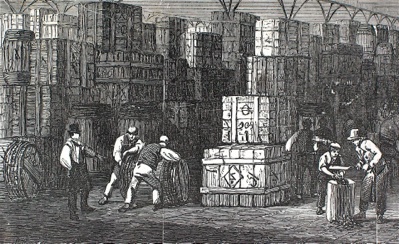

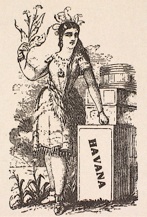

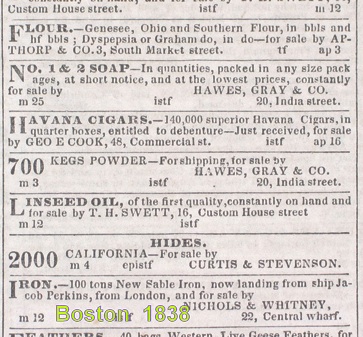
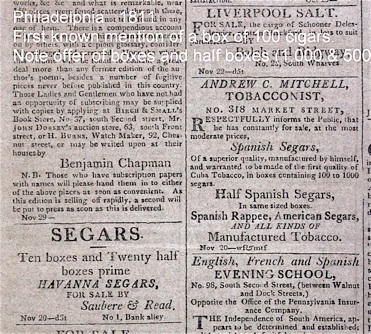
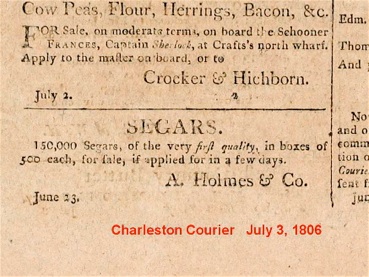
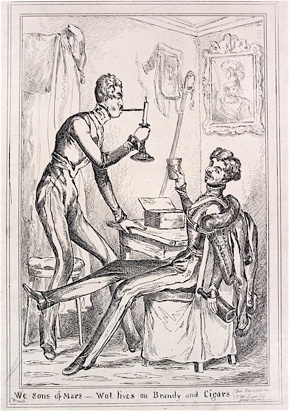
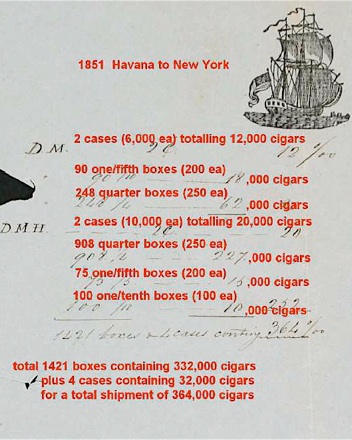

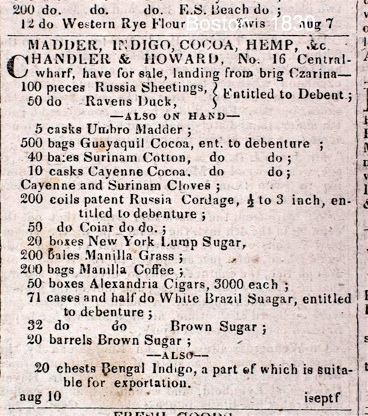

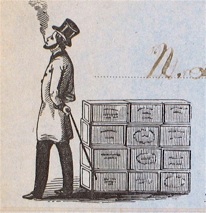


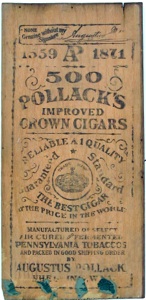
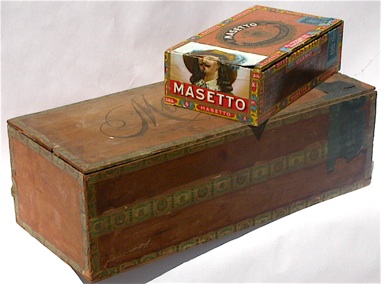
Saloon box
In the days before consumer size boxes became prevalent, cigars were transferred from large boxes to smaller containers like this, opened with a thumb-controlled lever next to the rear handle. Paying customers in restaurants and saloons were offered cigars, stogies or cheroots free or at minimal cost. This example circa 1835. Very rare today.
[3447]
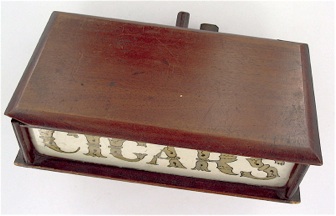
Modern terminology remains a remnant of bygone days
In the 1851 cargo list seen above, you’ll notice that the size of a cigar box is referred to as a fraction of 1000. A box containing 500 cigars is half of 1,000 abbreviated 1/2. A box of 250 is one-quarter of 1,000, abbreviated 1/4. A box of 200 is called a 1/5th. A box of 100 cigars is a 1/10. They are not listed on this particular invoice, but the practice continues for smaller boxes. A box containing 50 cigars is 1/20. A box containing 25 cigars is abbreviated 1/40. These abbreviations remained standard throughout the cigar industry for more than a century. You’ll see them used sometimes today, 200 years after they first appeared.
After 1891, you’ll occasionally see 1/80th, which isn’t technically possible since that would be a box containing 12 ½ cigars. Close. It was an industry convention meaning a “sample box” which could legally be manufactured to hold either 12 or 13 cigars. Check out the NCM exhibit of salesmen's samples to learn more about these.
When revenue stamps were no longer required after 1959, odd size boxes of 30, 60, etc., began to appear on the market. These sizes weren’t easily expressible in traditional fractions of 1,000 so it became common for packers, wholesalers, salesmen and retailers to describe boxes in terms of the actual count, rather than as a traditional fraction of a now unknown “box” of 1,000.
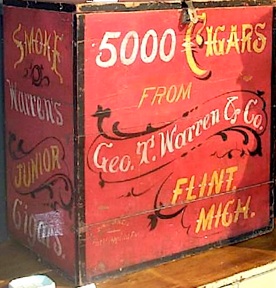

Shipped from St. Iago, Cuba (Santiago) to Philadelphia in 1821, not long after Cuba was opened officially to international trade:
300 Seroons Tobacco
49 quarter Boxes of Segars
4 Puncheons Rum
4 Boxes Castile Soap
50 Boxes Brown Soap
Those were the commercial goods. Then the Sea Stores, provisions for the crew:
Two barrels Bread
Part of a barrel Pork
Part of a barrel Beef
about 10 bags Coffee
Half barrel Sugar
A seroon is a bale wrapped in cowhide rather than typical palm leaf. A Bbl is a barrel.
The cigars were all packed in quarter-boxes holding 250.
A “box” contained 1,000.
[0123]
In 1813, a Colonel in the British Grenadier Guards dismissed a complaint about short rations during the 1812 war against France and the United States, saying his soldiers thrived on a diet of “brandy and cigars.”
This 1826 British print illustrates “We Sons of Mars -- Wot lives on Brandy and Cigars.”
The cigar box on the table of these two disciples of the War God is the earliest European print depiction of a commercial box of cigars in the NCM collection. It is a customer sized, retail package, a box of 100.
[0128]
At the beginning of the Civil War in the early 1860’s
stores still offered cigars in large boxes. The quarter-boxes seen here held 250 cigars; the contents were typically sold individually.
Retailers wrapped cigars in paper bundles or used recently invented paper bags. Note the boxes are branded only with the vitola/frontmark (size and shape). Regalias and Londres were two of the most popular.
[9720]
Considering the millions of cigars shipped in the first half of the 1800’s, very few boxes (almost none) have survived.
They were fragile, but even more important, they supplied generations of home craftsmen and boys with the thin fine-grained raw materials for endless projects. After 1863, boxes of 1,000 were, for reasons now unknown, made illegal.
[0398] [0399]